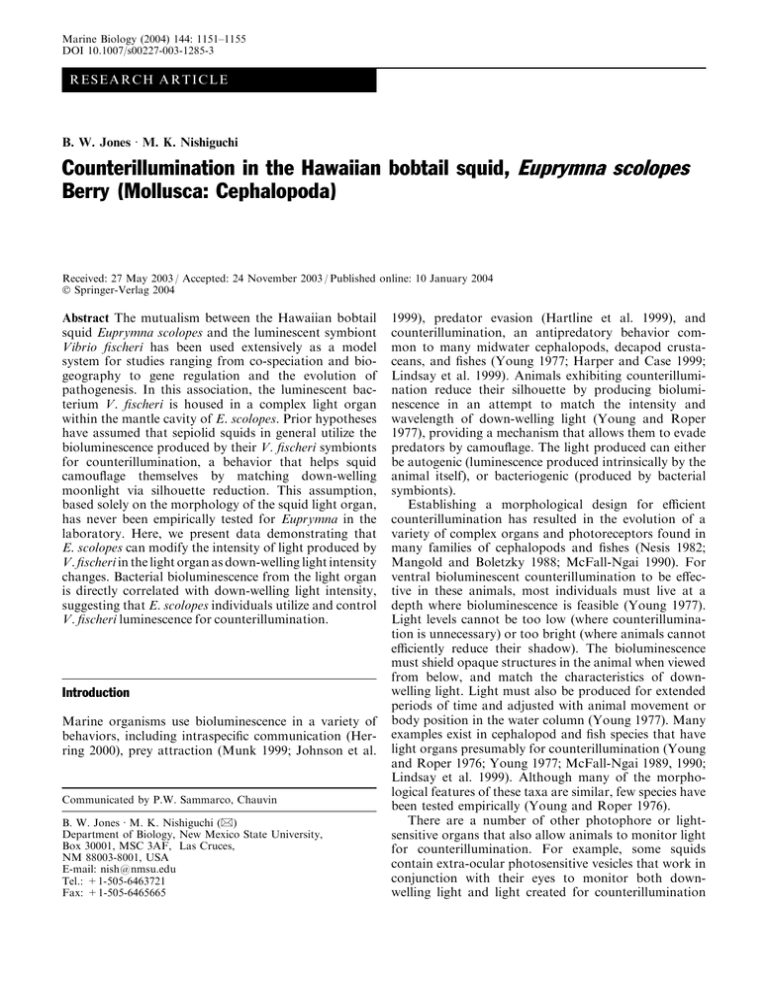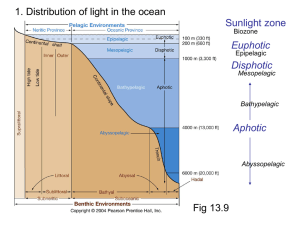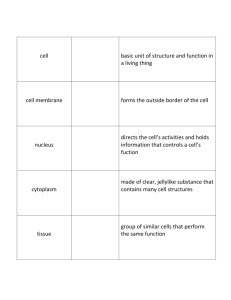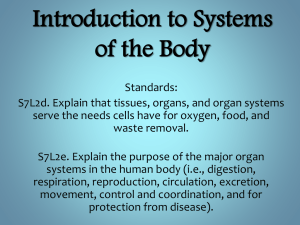Euprymna scolopes Counterillumination in the Hawaiian bobtail squid, Berry (Mollusca: Cephalopoda)
advertisement

Marine Biology (2004) 144: 1151–1155 DOI 10.1007/s00227-003-1285-3 R ES E AR C H A RT I C L E B. W. Jones Æ M. K. Nishiguchi Counterillumination in the Hawaiian bobtail squid, Euprymna scolopes Berry (Mollusca: Cephalopoda) Received: 27 May 2003 / Accepted: 24 November 2003 / Published online: 10 January 2004 Ó Springer-Verlag 2004 Abstract The mutualism between the Hawaiian bobtail squid Euprymna scolopes and the luminescent symbiont Vibrio fischeri has been used extensively as a model system for studies ranging from co-speciation and biogeography to gene regulation and the evolution of pathogenesis. In this association, the luminescent bacterium V. fischeri is housed in a complex light organ within the mantle cavity of E. scolopes. Prior hypotheses have assumed that sepiolid squids in general utilize the bioluminescence produced by their V. fischeri symbionts for counterillumination, a behavior that helps squid camouflage themselves by matching down-welling moonlight via silhouette reduction. This assumption, based solely on the morphology of the squid light organ, has never been empirically tested for Euprymna in the laboratory. Here, we present data demonstrating that E. scolopes can modify the intensity of light produced by V. fischeri in the light organ as down-welling light intensity changes. Bacterial bioluminescence from the light organ is directly correlated with down-welling light intensity, suggesting that E. scolopes individuals utilize and control V. fischeri luminescence for counterillumination. Introduction Marine organisms use bioluminescence in a variety of behaviors, including intraspecific communication (Herring 2000), prey attraction (Munk 1999; Johnson et al. Communicated by P.W. Sammarco, Chauvin B. W. Jones Æ M. K. Nishiguchi (&) Department of Biology, New Mexico State University, Box 30001, MSC 3AF, Las Cruces, NM 88003-8001, USA E-mail: nish@nmsu.edu Tel.: +1-505-6463721 Fax: +1-505-6465665 1999), predator evasion (Hartline et al. 1999), and counterillumination, an antipredatory behavior common to many midwater cephalopods, decapod crustaceans, and fishes (Young 1977; Harper and Case 1999; Lindsay et al. 1999). Animals exhibiting counterillumination reduce their silhouette by producing bioluminescence in an attempt to match the intensity and wavelength of down-welling light (Young and Roper 1977), providing a mechanism that allows them to evade predators by camouflage. The light produced can either be autogenic (luminescence produced intrinsically by the animal itself), or bacteriogenic (produced by bacterial symbionts). Establishing a morphological design for efficient counterillumination has resulted in the evolution of a variety of complex organs and photoreceptors found in many families of cephalopods and fishes (Nesis 1982; Mangold and Boletzky 1988; McFall-Ngai 1990). For ventral bioluminescent counterillumination to be effective in these animals, most individuals must live at a depth where bioluminescence is feasible (Young 1977). Light levels cannot be too low (where counterillumination is unnecessary) or too bright (where animals cannot efficiently reduce their shadow). The bioluminescence must shield opaque structures in the animal when viewed from below, and match the characteristics of downwelling light. Light must also be produced for extended periods of time and adjusted with animal movement or body position in the water column (Young 1977). Many examples exist in cephalopod and fish species that have light organs presumably for counterillumination (Young and Roper 1976; Young 1977; McFall-Ngai 1989, 1990; Lindsay et al. 1999). Although many of the morphological features of these taxa are similar, few species have been tested empirically (Young and Roper 1976). There are a number of other photophore or lightsensitive organs that also allow animals to monitor light for counterillumination. For example, some squids contain extra-ocular photosensitive vesicles that work in conjunction with their eyes to monitor both downwelling light and light created for counterillumination 1152 (Young et al. 1979). Many cephalopods also have a photoreceptive nuchal organ (Parry 2000). This organ is found in the mantle cavity (a conserved morphological trait), which differs from other photosensitive vesicles found in many decapod cephalopods (Parry 2000). Although it has the morphology of a photoreceptive organ, the function of the nuchal organ is unclear. The pineal complex also functions as a light receptor in the lanternfish, Triphoturus mexicanus (McNulty and Nafpaktitis 1976). This organ contains a number of receptor cells behind a translucent window, enabling photoreception. Both organ types enable the animal to detect light and respond in a manner that will help it conform to its surroundings (in this case, down-welling light). Sepiolid squids (Cephalopoda: Sepiolidae) utilize bacteriogenic light from a variety of luminescent symbionts, mostly in the genera Vibrio and Photobacterium (Ruby and Nealson 1976; Nealson and Hastings 1991). The bacteria are housed in a bilobed light organ that is located within the mantle cavity of the squid (Fig. 1A). This light organ contains a number of unique tissue layers, including the mesodermally derived reflective tissue and lens (Fig. 1B), which reflects (reflector) and focus (lens) light ventrally (Montgomery and McFallNgai 1992); the ectodermally derived crypts (Fig. 1B), which invaginate to form cavities where the bacteria reside (Montgomery and McFall-Ngai 1994); and an ink sac which enables the squid to control the intensity of light produced by functioning as a diaphragm around the light organ complex (McFall-Ngai and Montgomery 1990). Together, these tissues form a dynamic and complex organ that allows the squid to focus light ventral (Fig. 1A) to its body cavity while swimming (Montgomery and McFall-Ngai 1993). The distinct and unique morphology of the bacteriogenic light organ has led researchers to hypothesize that it is involved in counterillumination. Since sepiolid squids are nocturnal, they are known to be active predators only after dusk. During the day, squids bury themselves in the sand to evade diurnal predators. Previous research has demonstrated that 95% of the bacteria in the light organ are vented daily with the onset of dawn (Boettcher et al. Fig. 1 A Cartoon diagram of the Hawaiian bobtail squid, Euprymna scolopes, with a schematic of the light organ exposed within the mantle cavity. Drawing by G. Williams. B A saggital section of the light organ, which contains a variety of tissues, including dorsal reflective tissue (R), the epithellia-lined crypts (E) housing Vibrio fischeri symbionts, diverticulum (D) and lens (L). Photo by M.J. McFall-Ngai 1996), presumably to reduce the metabolic costs of maintaining a full bacterial population in the light organ (Nyholm and McFall-Ngai 1998). In an adult sepiolid squid, this approximates to 1012 bacteria in one entire light organ (Ruby and Asato 1993). During daytime hours, numbers of bacteria slowly increase from the remaining 5%, until the full complement of bacteria is attained by dusk when bioluminescence is needed for predator evasion (Boettcher et al. 1996; Nishiguchi et al. 1996; McFall-Ngai 1999; Nishiguchi 2001). Morphological and physiological evidence have led researchers to assume that the light organ is used for counterillumination. At this time, no studies have shown whether E. scolopes responds to changes in down-welling light with respect to immediate changes in its surrounding environment. Therefore, we have chosen to test this hypothesis by monitoring E. scolopes behavior with respect to changes in artificially produced down-welling light. Materials and methods Thirty-two E. scolopes individuals were collected from Paiko Beach (Honolulu, Hawaii) for use in the experiments. Animals were collected at low tide after sunset near the shoreline using a flashlight and handheld dip net. Animals were brought back to the University of Hawaii Kewalo Marine Laboratory and acclimated in running seawater tanks until ready for transport. After 4–5 days, animals were then transported to our squid facilities at New Mexico State University and maintained in a 379-L re-circulating tank held at 22°C in 34 ppt seawater (Instant Ocean) with a 12:12 h light:dark cycle. All counterillumination measurements were made approximately 2–4 h after the room lights were turned off for the evening. Each squid was placed in a small, seawater filled, clear plastic chamber that was approximately the length and width of the animal in order to restrict any movement. This chamber was then placed within an opaque compartment that inhibited horizontally directed light and enabled down-welling light to be detected by the animal. A counterillumination device was used to measure both overhead light and luminescence that was produced by each squid (Fig. 2). This apparatus consisted of a 3.2-mm fiber-optic probe connected to an EMI 9789 photomultiplier tube. Light intensity Fig. 2 The luminescence apparatus. Diffuse filters in front of the light source modified the intensity of light reaching E. scolopes. Bioluminescence was detected by the fiber-optic probe connected to the photomultiplier tube (PM) and intensity recordings were read from the ampmeter. Ambient light intensity measurements were taken in the identical apparatus not containing a specimen 1153 values were displayed on a digital Keithley Instruments Model 480 picoampmeter. A diffuse light source was used and projected in the room for each of the experimental trials, and intensity measurements (in microamperes) were recorded. To quantify down-welling light intensities, the fiber-optic probe was placed directly below an identical chamber to that previously described, without any squid present. To measure bioluminescence, the probe was placed directly beneath the light organ of each squid in the chamber after the animal had acclimated to a particular light level for 5 min. Since the mantle of Euprymna is somewhat translucent, it was impossible to measure bioluminescence directly while the lights were on without overhead light contamination. For this reason, bioluminescence intensity measurements were taken immediately as the overhead light was turned off. Animals were subjected to three different types of experiments, which consisted of measuring bioluminescence at (1) periods of 5-min intervals of increased down-welling light followed by 5-min intervals of no light; (2) acclimation to light at high levels (approximately 0.09 lA) for 5 min, followed by 15-s intervals with no down-welling light source; and (3) varying down-welling light intensities, including intensities where squids could not efficiently countershade. Six squids were tested for each type of light trial. Statistical analyses of light intensity and squid bioluminescence were used to estimate degree of correlation between the two. 2, Fig. 3B). Some animals did not emit any luminescence when multiple trials were attempted. Those animals seemed to be perturbed by the manipulations and were not used for the remainder of the experiments. Overhead light intensity was strongly correlated with bioluminescence of E. scolopes individuals when tested for all types of light fluctuations (Fig. 4A; r2=0.89– 0.96). We found that animals were able to increase their light emission up to tenfold. Ventral bioluminescence decreased in intensity after squids were exposed to increased light levels. This is shown in Fig. 4B, where bioluminescence and down-welling light were highly correlated (r2=.90) except at high light intensities, where squids reduced their bioluminescence. We also observed that if animals were perturbed during any point in the trial (sudden movement of the investigator), they would ink in the chamber or reduce or eliminate their luminescence, which terminated the experimental trial and measurements. Results Discussion and conclusions Figure 3 demonstrates the amount of light produced by each squid as down-welling light intensity changed during each trial. As the artificial light source was increased or decreased to different levels, each squid was able to adjust luminescence accordingly, even when light levels increased or decreased over multiple cycles (Fig. 3A). Squids only produced a fraction (about onethird) of bioluminescence at higher intensities (Fig. 3A). During consecutive trials, squid bioluminescence was also monitored after the artificial light source was terminated for light-acclimated animals. Two responses were observed for those trials; first, either squids terminated bioluminescence from their light organs within about 15 s (squid 3, Fig. 3B), or light production gradually decreased over a period of 2–3 min (squids 1 and This is the first reported study that demonstrates counterillumination by E. scolopes. Even though counterillumination has been shown in other related cephalopod species, this information provides a number of insights for studying the interactions between hosts that contain light organs and their luminescent symbionts. E. scolopes appears to control light emission in a rapid, practical manner in response to down-welling light (Fig. 3A). Each squid was able to appropriately adjust its own inherent bioluminescence intensity over a period of increasing or decreasing down-welling light. As previously noted in other cephalopods by Young et al. (1980), test animals would increase their light production with increasing down-welling light to a certain intensity, then decrease bioluminescence at higher light levels (Fig. 4B). This may be due to the need to decrease the amount of energy required to support the metabolically expensive bacterial light production reactions at high light levels where counterillumination is no longer effective (Ruby 1999; Ruby and McFall-Ngai 1999). Also, the amount of bacteria in an adult sepiolid squid is approximately 1012 cells (McFall-Ngai and Ruby 1991) and the light limi- Fig. 3 A Changes in the intensity of light produced by E. scolopes during one trial (1 h) in which down-welling light levels were slowly increased, decreased, and repeated. B Two types of responses by E. scolopes when overhead light (approximately 0.09 lA) was terminated after 5 min of light exposure. Squids 1 and 2 slowly decreased light production whereas squid 3 stopped light production within 15 s 1154 Fig. 4 A Two examples of the correlation between overhead light intensity and E. scolopes ventral bioluminescence. B Reduction of ventral bioluminescence at increased down-welling light intensities. The regression was performed on the first four data points tations on that concentration of bacteria may also limit the bioluminescence produced by an individual squid. Finally, in the natural environment of sepiolids, light levels probably do not exceed the levels to which squids produce bioluminescence (Young 1977). As mentioned, E. scolopes has two behavioral responses that reduce light production after down-welling light has been terminated. In the first response, bioluminescence from the squid decreases rapidly, due to either (1) the ink sac diverticula that act as an iris to control the intensity of emission (McFall-Ngai 1999), or (2) yellow filters that are present over the ventral surface that may act to shift the wavelength of luminescence (McFall-Ngai 1999). The second response is a slow decline in light production over a period of 2–3 min (Fig. 3B). It has been previously suggested that oxygen limitation in the light organ crypts by the host may be used to control bacterial light production since oxygen is a necessary component of the luminescence reactions (Hastings et al. 1987; Ruby 1996; Small and McFall-Ngai 1998; Ruby and McFallNgai 1999). The effect of oxygen limitation on light production has also been explored in the leiognathid fishes, which have a light organ that is separated from the gas bladder by an oxygen-permeable membrane (McFallNgai 1989). When oxygen concentrations within the gas bladder are experimentally increased, there is a concurrent increase in light production (McFall-Ngai 1989). This phenomenon is presumably responsible for controlling light produced by the bacterial symbionts. Accordingly, a source of oxygen for the light organ in sepiolid squids has not been identified, although several attempts have been made to discover what sources are responsible for the oxygen needed for the luciferase reactions (Small and McFall-Ngai 1998; Ruby and McFall-Ngai 1999; Visick et al. 2000). In our present study, it was not possible to examine whether each individual squid was decreasing luminescence by covering its light organ very slowly with its ink sac. The idea of oxygen limitation in the crypts leading to decreased luminescence, however, is an intriguing possibility to pursue in the future. While it is clear that E. scolopes is attempting counterillumination, whether this behavior confers a fitness advantage has yet to be investigated. To date, only one study using the plainfish midshipman Porichthys notatus has successfully attempted to quantify the reduction in predation by counterilluminating animals (Harper and Case 1999). In this study, both juvenile non-luminous and luminous P. notatus were exposed to predation by conspecific adults. In dim light, luminous juveniles were preyed upon significantly less than their non-luminous counterparts. Similar experiments presenting both aposymbiotic and symbiotic E. scolopes to an appropriate predator may verify whether counterillumination does increase survival (and therefore, fitness). Work by Nishiguchi et al. (1998) and by Nishiguchi (2002) has shown the association between sepiolid squids and their bacterial endosymbionts to be highly specific for bacteria that are capable of producing luminescence in squid light organs. Other experiments have shown that once bacterial genes responsible for light production are removed, there is a decrease in colonization efficiency and induction of cell swelling in the host epithelia (Visick et al. 2000). Future experiments examining the quality of light produced by non-native symbionts in E. scolopes and whether a better adapted symbiont affects host fitness will provide interesting and valuable information about the nature of local adaptation and specificity among symbiotic partners. Acknowledgements We would like to thank R.E. Young for donating the counterillumination apparatus and assisting in the initial stages of this project. Drs. M.J. McFall-Ngai and E.G. Ruby from the Kewalo Marine Laboratory at the University of Hawaii have been generous with space and tanks during collection of Euprymna on the island of Oahu, Hawaii. The authors greatly appreciate the help of J. Bitsoie and E. Amezquita for their assistance during midnight hours for all counterillumination experiments. We would also like to acknowledge two anonymous reviewers and members of the Nishiguchi lab for their suggestions and comments during the project and on the manuscript. Funding was provided by NSF DEB-0316516, NSF DBI-0079820, NSF SBE-0123690, and NIH SO6-GM08136-26 grants to M.K.N., and NIH-RISE GM61222-01, NIH-MARC GM0766724, and NIH-BRIDGES GM48998 for support of minority undergraduates (Amezquita and Bitsoie) at NMSU. All experiments comply with the current laws of the country in which the experiments were performed (U.S.A.). References Boettcher KJ, Ruby EG, McFall-Ngai MJ (1996) Bioluminescence in the symbiotic squid Euprymna scolopes is controlled by a daily biological rhythm. J Comp Physiol B 179:65–73 1155 Harper RD, Case JF (1999) Counterillumination and its antipredatory value in the plainfin midshipman fish Porichthys notatus. Mar Biol 134:529–540 Hartline DK, Buskey EJ, Lenz PH (1999) Rapid jumps and bioluminescence elicited by controlled hydrodynamic stimuli in a mesopelagic copepod, Pleuromamma xiphias. Biol Bull 197:132– 143 Hastings JW, Makemson JC, Dunlap PV (1987) How are growth and luminescence regulated independently in light organ symbionts? Symbiosis 4:3–24 Herring PJ (2000) Species abundance, sexual encounter and bioluminescent signaling in the deep sea. Philos Trans R Soc Lond B 355:1273–1276 Johnson S, Balser EJ, Fisher EC, Widder EA (1999) Bioluminescence in the deep-sea cirrate octopod Stauroteuthis syrtensis Verrill (Mollusca: Cephalopoda). Biol Bull 197:26–39 Lindsay SM, Frank TM, Kent J, Partridge JC, Latz MI (1999) Spectral sensitivity of vision and bioluminescence in the midwater shrimp, Sergestes similis. Biol Bull 197:348–360 Mangold K, Boletzky S (1988) Mediterranean cephalopod fauna. In: Clarke MR, Trueman ER (eds) The Mollusca. Academic Press, San Diego, Calif., pp 315–330 McFall-Ngai MJ (1989) Luminous bacterial symbiosis in fish evolution: adaptive radiation among the Leiognathid fishes. In: Margulis L, Fester R (eds) Symbiosis as a source of evolutionary innovation. MIT Press, Cambridge, Mass., pp 381–409 McFall-Ngai MJ (1990) Crypsis in the pelagic environment. Am Zool 30:175–188 McFall-Ngai MJ (1999) Consequences of evolving with bacterial symbionts: lessons from the squid-vibrio association. Annu Rev Ecol Syst 30:235–256 McFall-Ngai MJ, Montgomery MK (1990) The anatomy and morphology of the adult bacterial light organ of Euprymna scolopes Berry (Cephalopoda: Sepiolidae). Biol Bull 179:332–339 McFall-Ngai MJ, Ruby EG (1991) Symbiont recognition and subsequent morphogenesis as early events in an animal–bacterial symbiosis. Science 254:1491–1494 McNulty JA, Nafpaktitis BG (1976) The structure and development of the pineal complex in the lanternfish Triphoturus mexicanus (family Myctophidae). J Morphol 150:579–605 Montgomery MK, McFall-Ngai MJ (1992) The muscle-derived lens of a squid bioluminescent organ is biochemically convergent with the ocular lens. Evidence for recruitment of aldehyde dehydrogenase as a predominant structural protein. J Biol Chem 267:20999–21003 Montgomery MK, McFall-Ngai M (1993) Embryonic development of the light organ of the Sepiolid squid Euprymna scolopes Berry. Biol Bull 184:296–308 Montgomery MK, McFall-Ngai MJ (1994) Bacterial symbionts induce host organ morphogenesis during early postembryonic development of the squid Eupyrmna scolopes. Development 120:1719–1729 Munk O (1999) The escal photophore of ceratioids (Pisces: Ceratioidei): a review of structure and function. Acta Zool (Stockholm) 80:265–284 Nealson KH, Hastings JW (1991) The luminous bacteria. In: Balows A, Truper HG, Dworkin M, Harder W, Schleifer KH (eds) The Prokaryotes, a handbook on the biology of bacteria: ecophysiology, isolation, identification, applications. Springer, Berlin Heidelberg New York, pp 625–639 Nesis KN (1982) Cephalopods of the world. TFH Publications, Neptune City, N.J. Nishiguchi MK (2001) Co-evolution of symbionts and hosts: The sepiolid-Vibrio model. In: Seckbach J (ed) Symbiosis: mechanisms and model systems. Cole-Kluwer Academic, Dordrecht, The Netherlands, pp 757–774 Nishiguchi MK (2002) Host-symbiont recognition in the environmentally transmitted sepiolid squid-Vibrio mutualism. Microb Ecol 44:10–18 Nishiguchi MK, Lamarcq LH, Ruby EG, McFall-Ngai MJ (1996) Competitive dominance of native strain symbiotic bacteria measured by colonization and in situ hybridization. Am Zool 36:41A Nishiguchi MK, Ruby EG, McFall-Ngai MJ (1998) Competitive dominance among strains of luminous bacteria provides an unusual form of evidence for parallel evolution in sepiolid squid-vibrio symbioses. Appl Environ Microbiol 64:3209–3213 Nyholm SV, McFall-Ngai MJ (1998) Sampling the light-organ microenvironment of Euprymna scolopes: description of a population of host cells in association with the bacterial symbiont Vibrio fischeri. Biol Bull 195:89–97 Parry M (2000) A description of the nuchal organ, a possible photoreceptor, in Euprymna scolopes and other cephalopods. J Zool (Lond) 252:163–177 Ruby EG (1996) Lessons from a cooperative, bacterial-animal association: the Vibrio fischeri–Euprymna scolopes light organ symbiosis. Annu Rev Microbiol 50:591–624 Ruby EG (1999) Ecology of a benign ‘‘infection’’: colonization of the squid luminous organ by Vibrio fischeri. American Society of Microbiology, Washington, D.C. Ruby EG, Asato LM (1993) Growth and flagellation of Vibrio fischeri during initiation of the sepiolid squid light organ symbiosis. Arch Microbiol 159:160–167 Ruby EG, McFall-Ngai MJ (1999) Oxygen-utilizing reactions and symbiotic colonization of the squid light organ by Vibrio fischeri. Trends Microbiol 7:414–420 Ruby EG, Nealson KH (1976) Symbiotic associations of Photobacterium fischeri with the marine luminous fish Monocentris japonica: a model of symbiosis based on bacterial studies. Biol Bull 151:574–586 Small AL, McFall-Ngai MJ (1998) A halide peroxidase in tissues interacting with bacteria in the squids Euprymna scolopes. J Cell Biochem 72:445–457 Visick KL, Foster JS, Doino JA, McFall-Ngai MJ, Ruby EG (2000) Vibrio fischeri lux genes play and important role in colonization and development of the host light organ. J Bacteriol 182:4578–4586 Young RE (1977) Ventral bioluminescent countershading in midwater cephalopods. Symp Zool Soc Lond 38:161–190 Young RE, Roper CFE (1976) Bioluminescent countershading in mid-water animals: evidence from living squid. Science 191:1046–1048 Young RE, Roper CFE (1977) Intensity regulation of bioluminescence during countershading in living midwater animals. Fish Bull U S:239–252 Young RE, Roper CFE, Walters JF (1979) Eyes and extraocular photoreceptors in midwater cephalopods and fishes: their roles in detecting down-welling light for counterillumination. Mar Biol 51:371–380 Young RE, Kampa EM, Maynard SD, Mencher FM, Roper CFE (1980) Counterillumination and the upper depth limits of midwater animals. Deep-Sea Res 27A:671–691






